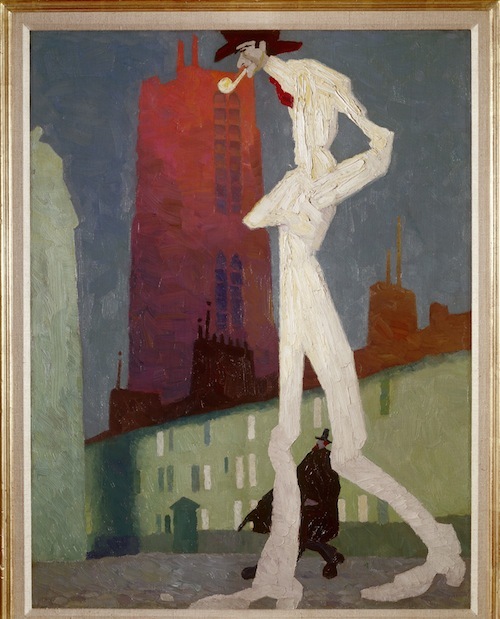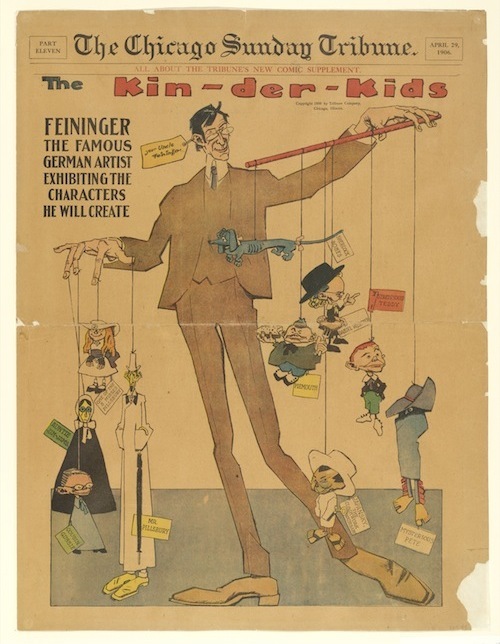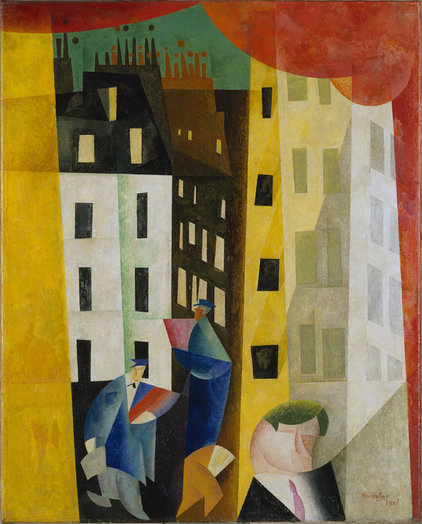Wednesday, July 25, 2012
Lyonel Feininger: At the Edge of the World
Lyonel Feininger, The White Man, 1907, Oil on canvas, 26 7/8 x 20 5/8 in. (68.3 x 52.3 cm), Collection of Carmen Thyssen-Bornemisza, © 2011 Lyonel Feininger Family, LLC./Artists Rights Society (ARS), New York
Lyonel Feininger, In a Village Near Paris (Street in Paris, Pink Sky), 1909. Oil on canvas, 39 3/4 x 32 in. (101 x 81.3 cm) University of Iowa Museum of Art, Iowa City; gift of Owen and Leone Elliott 1968.15 © Lyonel Feininger Family, LLC./Artists Rights Society (ARS), New York
Lyonel Feininger, Carnival in Arcueil, 1911. Oil on canvas, 41 3/10 × 37 8/10 in (104.8 × 95.9 cm). Art Institute of Chicago; Joseph Winterbotham Collection 1990.119, © Lyonel Feininger Family, LLC./Artists Rights Society (ARS), New York, Photograph © The Art Institute of Chicago
Lyonel Feininger has long been recognized as a major figure of the Bauhaus, renowned for his romantic, crystalline depictions of architecture and the Baltic Sea. Yet the range and diversity of his achievement are less well known. Lyonel Feininger: At the Edge of the World, the artist’s first retrospective in the United States in forty-five years, was the first ever to incorporate the full breadth of his art by integrating his well-known oils with his political caricatures and pioneering Chicago Sunday Tribune comic strips; his figurative German Expressionist compositions; his architectural photographs of Bauhaus and New York subjects; his miniature hand-carved, painted wooden figures and buildings, known as City at the Edge of the World; and his ethereal late paintings of New York City. Curated by Barbara Haskell with the assistance of Sasha Nicholas, the exhibition debuted at the Whitney Museum of American Art from June 30 to October 16, 2011, and subsequently traveled to The Montreal Museum of Fine Arts, January 16 – May 13, 2012.
Born and raised in New York City, Lyonel Feininger (1871–1956) moved at the age of sixteen to Germany to study music. Instead, he became a caricaturist and eventually a leading member of the German Expressionist groups Die Brücke and Die Blaue Reiter and, later, the Bauhaus. In the late 1930s, when the Nazi campaign against modern art necessitated his return to New York after an absence of fifty years, his marriage of abstraction and recognizable imagery made him a beloved artist in the United States.
Having spent fifty years of his life in Germany, Feininger is most often considered a German artist. This exhibition and its accompanying catalogue illuminate his dual national loyalties and their reverberations in his art. As Haskell notes in her catalogue essay: “(Feininger’s) complex and contradictory allegiances—to American ingenuity and lack of pretension on the one hand, and to German respect for tradition and learning on the other—rendered him an outsider in both countries. Always yearning for one world while living in the other, he never stopped longing for the ‘lost happiness’ of his childhood.”
Lyonel Feininger, "The Kin-der-Kids," from The Chicago Sunday Tribune, April 29, 1906, Commercial lithograph, 23 3/8 x 17 13/16 in. (59.4 x 45.3 cm), The Museum of Modern Art, New York; gift of the artist 260.1944.1 © 2011 Lyonel Feininger Family, LLC./Artists Rights Society (ARS), New York Photograph © The Museum of Modern Art/Licensed by SCALA / Art Resource, NY
Before he began to paint in 1907, at the age of thirty-six, Feininger had built a career as one of Germany's most successful caricaturists.
Newspaper Readers (1909)
When he turned to painting, he fused the whimsical figuration of his comic strips and illustrations with the high-keyed color of German Expressionist painting.
The Green Bridge
Just at the moment that Feininger's oils began to earn him widespread recognition, World War I broke out.
Self Portrait
He spent the war in Germany as an enemy alien, never having relinquished his American citizenship. In 1919, Walter Gropius, founder of the Bauhaus, appointed Feininger as the school's first professor and commissioned him to design the cover of the Bauhaus manifesto. Feininger's expressionist woodcut, depicting a tripartite cathedral surrounded by shooting stars, symbolized the school's idealistic unification of fine art, architecture, and crafts.
Feininger remained at the Bauhaus until it was closed by the Nazis in 1933, revered as a teacher and head of the school's graphics workshop. The monumental compositions of architectural and seascape subjects that he produced at the Bauhaus gained him national renown, culminating in his receipt in 1931 of Germany's highest honor for an artist: a large-scale retrospective at Berlin's National Gallery.
Lyonel Feininger. Gelmeroda XIII (Gelmeroda), 1936 Oil on canvas, 39 1/2 x 31 5/8 in. (100.3 x 80.3 cm.) The Metropolitan Museum of Art, New York; George A. Hearn Fund, 1942 42.158 © 2011 Lyonel Feininger Family, LLC./Artists Rights Society (ARS), New York Photograph © The Metropolitan Museum of Art / Art Resource, NY
When the Nazi Party came to power in 1933, the situation became unbearable for Feininger and his wife, who was Jewish. They moved to America in 1937, just months before his work was featured in the Nazi's infamous Degenerate Art exhibition. Readjusting to the changed landscape of New York was difficult after such a long absence; not until 1939 did Feininger begin painting again. In America, as in Germany, he employed geometric forms to invest the modern world with a secular spirituality. Art, for him, was a "path to the intangibly Divine,” a way of expressing what he called the “glory there is in Creation." At the same time, Feininger continued in his last years to call upon the playful figurative vocabulary of his early illustrations and comics to evoke the harmony and innocence of childhood. Feininger's 1944 retrospective at the Museum of Modern Art, which traveled for two years to major American cities, established him as a major artist in his native country during his final years.
Nice article
The Book
A monograph accompanying the exhibition, with its overview essay by Whitney curator Barbara Haskell, covers the full breadth of Feininger’s career, placing his biography and art within the context of art history and politics, tracing his relationships to movements and institutions that defined the development of modern art, including Cubism, the Blaue Reiter, the Blue Four, the Bauhaus, and Black Mountain College. The catalogue features additional essays by Ulrich Luckhardt, curator, Hamburger Kunsthalle, Germany; Sasha Nicholas, senior curatorial assistant, Whitney Museum of American Art, New York; Bryan Gilliam, Frances Hill Fox Professor in Humanities, Duke University; John Carlin, independent writer and curator, president and CEO of Funny Garbage. The book is published by the Whitney Museum of American Art, New York, in association with Yale University Press, New Haven and London.











